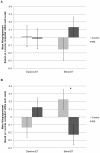Death and science: the existential underpinnings of belief in intelligent design and discomfort with evolution
- PMID: 21479169
- PMCID: PMC3068159
- DOI: 10.1371/journal.pone.0017349
Death and science: the existential underpinnings of belief in intelligent design and discomfort with evolution
Abstract
The present research examined the psychological motives underlying widespread support for intelligent design theory (IDT), a purportedly scientific theory that lacks any scientific evidence; and antagonism toward evolutionary theory (ET), a theory supported by a large body of scientific evidence. We tested whether these attitudes are influenced by IDT's provision of an explanation of life's origins that better addresses existential concerns than ET. In four studies, existential threat (induced via reminders of participants' own mortality) increased acceptance of IDT and/or rejection of ET, regardless of participants' religion, religiosity, educational background, or preexisting attitude toward evolution. Effects were reversed by teaching participants that naturalism can be a source of existential meaning (Study 4), and among natural-science students for whom ET may already provide existential meaning (Study 5). These reversals suggest that the effect of heightened mortality awareness on attitudes toward ET and IDT is due to a desire to find greater meaning and purpose in science when existential threats are activated.
Conflict of interest statement
Figures





Similar articles
-
Further Exploring the Link Between Religion and Existential Health: The Effects of Religiosity and Trait Differences in Mentalizing on Indicators of Meaning in Life.J Relig Health. 2017 Apr;56(2):604-613. doi: 10.1007/s10943-016-0274-z. J Relig Health. 2017. PMID: 27357581
-
Exploring the existential function of religion: the effect of religious fundamentalism and mortality salience on faith-based medical refusals.J Pers Soc Psychol. 2009 Aug;97(2):334-50. doi: 10.1037/a0015545. J Pers Soc Psychol. 2009. PMID: 19634979
-
Evolution Controversy: A Phenomenon Prompted by the Incompatibility between Science and Religious Beliefs.Int J Sci Soc. 2015 Jun;7(2):1-23. Epub 2015 May 14. Int J Sci Soc. 2015. PMID: 26877774 Free PMC article.
-
The cocreating environment: a nexus between classical Chinese and current nursing philosophies.ANS Adv Nurs Sci. 2008 Oct-Dec;31(4):356-64. doi: 10.1097/01.ANS.0000341415.03963.b3. ANS Adv Nurs Sci. 2008. PMID: 19033750 Review. No abstract available.
-
Creationism and intelligent design.Annu Rev Genomics Hum Genet. 2003;4:143-63. doi: 10.1146/annurev.genom.4.070802.110400. Annu Rev Genomics Hum Genet. 2003. PMID: 14527300 Review.
Cited by
-
Posterior medial frontal cortex and threat-enhanced religious belief: a replication and extension.Soc Cogn Affect Neurosci. 2020 Dec 24;15(12):1361-1367. doi: 10.1093/scan/nsaa153. Soc Cogn Affect Neurosci. 2020. PMID: 33180108 Free PMC article.
-
Investigating the Role of Normative Support in Atheists' Perceptions of Meaning Following Reminders of Death.Front Psychol. 2022 Jul 5;13:913508. doi: 10.3389/fpsyg.2022.913508. eCollection 2022. Front Psychol. 2022. PMID: 35865689 Free PMC article.
-
A Sense of Continuity in Mortality? Exploring Science-Oriented Finns' Views on Afterdeath.Omega (Westport). 2023 Nov;88(1):38-65. doi: 10.1177/00302228211038820. Epub 2021 Aug 18. Omega (Westport). 2023. PMID: 34407669 Free PMC article.
-
A field guide for teaching evolution in the social sciences.Evol Hum Behav. 2018 May;39(3):257-268. doi: 10.1016/j.evolhumbehav.2018.01.002. Epub 2018 Jan 31. Evol Hum Behav. 2018. PMID: 38827656 Free PMC article.
-
Scientific faith: Belief in science increases in the face of stress and existential anxiety.J Exp Soc Psychol. 2013 Nov;49(6):1210-1213. doi: 10.1016/j.jesp.2013.05.008. J Exp Soc Psychol. 2013. PMID: 24187384 Free PMC article.
References
-
- American Association for the Advancement of Science. Statement on the teaching of evolution. 2006. Available: http://www.aaas.org/news/releases/2006/pdf/0219boardstatement.pdf. Accessed 2008 Dec 16.
-
- Bumiller E. Bush remarks roil debate on teaching of evolution. 2005. The New York Times. Available: http://www.nytimes.com/2005/08/03/politics/03bush.html. Accessed 2008 July 2.
-
- Gewin V. Scientists attack Bush over intelligent design. Nature. 2005;436:761. - PubMed
-
- Hoag H. Doubts over evolution block funding by Canadian agency. Nature. 2006;440:720–721. - PubMed
Publication types
MeSH terms
LinkOut - more resources
Full Text Sources
Medical

